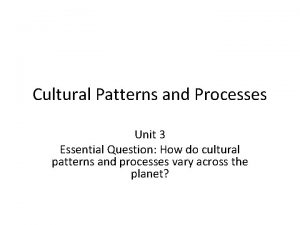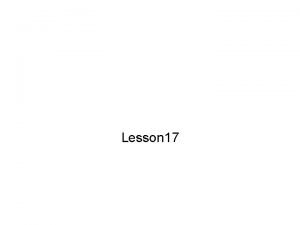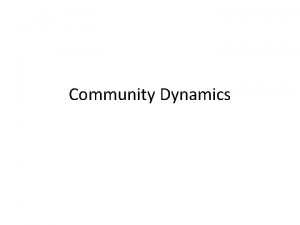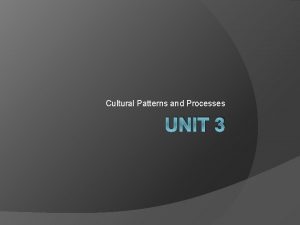Topic III Cultural Patterns and Processes If you

































- Slides: 33

Topic III: Cultural Patterns and Processes

If you Learn only 8 Things in this Chapter… 1. 2. 3. 4. Language is the means of mutually comprehensible communication among people. n There are thousands of languages around the world, but many of them are dying out. Folk culture is practiced by a relatively small number of people in a particular area. n Popular Culture is diffused rapidly around the world through mass communication. Indo European language family is the largest (including Romance and Germanic languages) n Sino-Tibetan family is the second largest (includes Mandarin Chinese). Dialects are forms of language that differ based on vocabulary, syntax, and speed. 1. 2. 3. 4. There are 5 primary religions: Christianity (largest religion), Islam (fastest growing), Judaism, Hinduism and Buddhism (Eastern religions). Monotheistic religions v. Polytheistic religions (one god or many) n Ethnic v. Universalizing religions (must be born into religion or can be converted to the religion) Religious Structures: Churches, Synagogues, Mosques, Temples, Pagodas Cultural landscapes can be read and interpreted based on cultural featureslanguage of signs, religious architecture, and even food preferences.

Folk & Popular Culture: Terms n HABIT n n CULTURE n n n “the body of material traits, customary beliefs, and social forms that constitute the distinct tradition of a group of people. ” “a collection of social customs produces a group’s material culture. ” DAILY NECESSITIES vs. LEISURE n n n “a repetitive act that a particular individual performs” Every group has to survive – eat, find shelter, clothing – but different groups have different ways of satisfying their needs. Leisure – games, music, art – are universal, but different groups express themselves in different ways. THE GEOGRAPHY OF CULTURE n n Every activity has a distinct spatial distribution. Every group takes elements from the environment into its culture and builds their own unique landscapes

THE MEANING OF CULTURE n n n Material Culture: Anything that can be seen (tangible) on the landscape, such as artifacts, houses, furniture, and musical instruments. Material culture produces the built environment- the tangible impact of human beings on the landscape. Nonmaterial Culture: Anything that makes up culture that cannot be touched, such as language, religion, as well as folklore, philosophies, and superstitions. n Customs: Practices followed by the people of a particular group n Traditions: A cohesive collection of customs n Cultural Traits: Specific customs that are part of everyday life (language, religion, etc. )

Folk vs. Popular n We n can look at culture at two scales: FOLK CULTURE n Small, fairly homogenous groups n Today, mostly isolated in rural areas n Spreads by relocation diffusion n POPULAR CULTURE n Large, diverse groups n Widespread, urban n Spreads through media/technology

Origins Every social custom develops in a particular place – a hearth. n Folk customs usually have anonymous origins – they come from unknown places (sometimes more than one place), from unknown people, at unknown times. n Popular customs are usually the product of developed countries, and their origins are often well known (and sometimes copyrighted!) n

Origins: Folk Customs n n n Folk Music n Every culture develops its own unique music. n In many cultures the distinction between “art” and “everyday object” is unclear – decoration is “just the way things are done. ” Folk Art Folk Housing n n n “Folk Food” n n People adapt their food preferences based on the environment – BUT beliefs and values strongly influence diet taboos. Folk Sports n n Must be made from locally available building materials. Distinctive forms – there is no “perfect” house design. People everywhere enjoy recreation – many places have developed unique forms of recreation and sports. Folk Beliefs n How does the world work? How should we behave?

Folk Music African mbira Australian didgeridoo n n n Hearths, American country music Usually composed anonymously. Usually transmitted orally. Content usually comes from everyday events in people’s lives. Possible Paleolithic flute, dated to 43, 000 BCE Sources: http: //helixmusic. com. au/posters/mbira. htm; http: //www. amol. org. au/; http: //www. calacademy. org/calwild/sum 98/horizons. htm

Folk Art n n Frequently, folk art pieces are just “traditional”; there is no “designer, ” no “artist” – just craftspeople. Often the “art” is included as part of the traditional way of making something – not specifically made as “art. ” Pennsylvania Dutch blanket chest Source: http: //www. nga. gov/collection/gallery/iadpenn-29268. 0. html

Folk Housing n Folk housing has several fundamental characteristics: n n It must deal adequately with the physical environment. It must be designed in such a way that people without special equipment or training can build it. It must be constructed from locally available materials. Remember: there is no “perfect” design. Different traditional house types from Eastern North America

Folk Housing: Diffusion in the Eastern U. S. Most important!

Folk Food & Food Taboos n Folk customs are always affected by what’s available – but also by culture. n What is acceptable for some cultures may be unacceptable – taboo – or even horrifying to others. Gathering tasty fly larvae, Mono Lake, CA

Folk Beliefs: Relocation Diffusion n n The Amish – originally a Swiss Mennonite group – have a distinctive culture and are now found in 28 US States. The Amish (and their beliefs) have spread by relocation diffusion – which is just about the only way folk cultures and their beliefs can spread. Source: http: //digitalunion. osu. edu/r 2/summer 07/eellis/

Popular Music n n Popular music is (usually) written or performed by known individuals who "own" it. Popular music is (usually) produced as a kind of commodity – for sale. Popular music tends to vary a lot more over time than from place to place. Modern popular music began about 100 years ago: n n n Performed in English "music halls" and in American “vaudeville, " and composed (and sold) by professionals in places like "Tin Pan Alley. " Global-scale diffusion during the First and Second World Wars. Continued and increasing diffusion by global mass media. Popular music clusters

Owning Popular Music: Copyright – “Happy Birthday to You” n n n Popular music belongs to the copyright holder. Sometimes people don’t realize a song is owned – “Happy Birthday to You” will not be in the Public Domain in the US until 2030. Until then, public income-generating performances have to pay a royalty to Warner/Chappell Music, Inc. (in some cases thousands of dollars!) Source: http: //www. warnerchappell. com/wcm_2/song_search/song_detail/songview_2. jsp? esong. Id=126621000&view=fulllyrics

Popular Art n Pablo Picasso, Dora Maar, 1938 n As with popular music, popular art is usually created by known individuals as a commodity – produced by professionals, and made to be sold. Innovation (and Damien Hirst, Mother & even shock value) Child, Divided (1993 is highly prized. Turner Prize winner) Sources: http: //www. tate. org. uk/magazine/issue 2/tpwin_image 2. htm; http: //www. fbi. gov/hq/cid/arttheft/asia/saudiart. htm

Popular Housing n n n Housing in popular culture is designed and built by professionals – not by the people who live in the houses. Popular housing is not limited to locally available building materials. Popular housing styles vary more over time than regionally — houses built in the 1950 s, for example, tend to look alike, regardless of where in the US they were built. Source: http: //www. capitalcentury. com/1950 sindex. html

Popular Food n n n In popular culture modern transportation methods mean that a wide variety of different kinds of food are available year-round – people are not limited to locally available crops. Food fads and food trends can change diets, so that what people prefer tends to vary more over time than over space. However, there certainly are variations in food preferences and consumption.

Popular Clothing n n n In popular culture, clothing may reflect occupation, and must (of course) protect the wearer from the environment. But clothing in popular culture is affected by fashion and trends. Just as with music, housing and other aspects of culture, popular clothing tends to vary more over time than from place to place. Welcome to the 1970 s! Sources: http: //lovetheseventies. blogspot. com/2011_05_01_archive. html; http: //topyaps. com/top-10 -clothing-styles-of-1970 s/; http: //www. huffingtonpost. com/2011/07/11/70 s-fashion-ads_n_885250. html#s 298879&title=Calvin_Klein_Jeans; http: //www. retro-housewife. com/1970 -fashion. html

Popular Beliefs n n Beliefs about the world and how people should live and behave are widely shared in popular culture. Widely shared concepts today: n n Democracy; free markets; individualism; rule of law; private property; family; work; the weekend; education; etc. Popular beliefs are spread by media -newspapers, magazines, radio and TELEVISION!!!!

TV Around the World Watching TV in Niger n n Category 1: Countries where most households (more than 50%) own at least one TV set (US, Japan). Category 2: Countries where TVs are common, but not universal (25%-49%) (Mexico, Thailand). Category 3: Countries where television exists, but is uncommon (5%-24%); few individuals own sets (Mongolia, Laos). Category 4: Countries where television is rare or nonexistent (less than 5%); virtually no TV sets (Bhutan, Chad). Data Source: World Bank Development and Data Statistics Table 5. 11: http: //www. worldbank. org/

The Internet n n In 1995 less than 10% of American adults were online; today more than 90% have online access. Worldwide, nearly three billion people have internet access – but access is still very limited in less developed areas. Source: http: //www. internetworldstats. com/stats. htm

Social Media: Regional Variations World map of social networks, 2011 n Social media may have taken over the world – Facebook now has over a billion users – but different networks dominate in different places. Source: http: //digitalbusybee. com/wp-content/uploads/2011/10/world-map-of-social-networks 2. jpg; See also: http: //vincos. it/world-map-of-social-networks/

Technology in the Developing World n The growth of cell phone use in Africa has been amazing: n n n In 2000 Nigeria had 100, 000 telephones. Today it has 100 million (almost all cellular phones). Kenya has seen cell phone use grown 500 -fold between 2000 and 2010. Rwanda phone use grew 50% in 2010 alone. Smart phones are rapidly increasing in popularity. Google plans to sell 200 million phones in Africa in the next few years. Some of the ways cell phones are changing Africa: n BANKING: 50% of adults in Kenya, Sudan and Gabon bank online using their phones, and this is spreading. n ACTIVISM: The Arab Spring is just one example of the n EDUCATION: In South Africa 10 million students are n ENTERTAINMENT: Games, online chat, music, and n EMERGENCIES: Used to mobilize and organize n AGRICULTURE: From rapidly updating weather n HEALTH: Alerts and updates, disease tracking, getting use of mobile media to influence change in Africa. learning mathematics through text messaging. specialized "channels" for movies and television. disaster services, help with refugees and find missing relatives. information to helping farmers with crop sales and marketing, to coordinating veterinary services. fake medicines out of the market, finding doctors -cell services are transforming health care in Africa. n There are more cell phone users in Africa today than there are in North America. Sources: http: //www. nytimes. com/2005/08/25/international/africa/25 africa. html? _r=1; http: //www. cnn. com/2012/09/13/world/africa/mobile-phones-change-africa/index. html? hpt=hp_c 2; http: //www. newyorker. com/online/blogs/newsdesk/2011/03/africa-cell-phone-revolution. html; http: //paidcontent. org/2012/04/03/e-books-for-smart-kids-on-dumb-phones/

Threats to Folk Cultures n Why worry? Why should we care? n n n When people turn away from traditional culture and customs, they may also turn away from a society’s traditional values. The ways of living and behaving that work in popular culture may not work so well in other cultures. On the other hand – traditional ways of living are not necessarily ideal either! n There are five basic kinds of threats to folk culture today: 1. Loss of traditional values 2. Foreign media imperialism 3. Adoption & commodification 4. Environmental threats 5. “Placelessness”

Threats to Folk Culture: Loss of Traditional Values n Changes in the role of women n n In many cultures it is traditional for women to be subservient to men (this was true here until quite recently!) In some cases, awareness of popular culture has meant that women can seek advancement, education, new roles. On the other hand, contact with popular culture almost always results in increased rates of exploitation. Women who try to change their roles or status may be subject to harassment and violence – although that certainly isn’t unique to folk cultures!

Threats to Folk Culture: Foreign Media Imperialism n n n Media from just three countries – the US, the UK and Japan – dominate entertainment and news in much of the less developed world. What they show may be offensive to (or subversive of) traditional values. Western news media dominate international news. News media within most less developed countries is largely government controlled. News networks tend to represent Western values and ideas – and may not present the points of view of less developed countries (or their governments). Western media are largely interested in disasters. Note that newspapers and radio stations are usually locally owned and operated – not foreign owned or controlled.

Threats to Folk Culture: The Environment n n n Folk cultures are dependent on the local environment. Although they may modify it, if they survive, they must be in some sense “in balance. ” Popular culture is much more likely to create pollution – toxic chemicals, sewage, etc. Popular culture is far less dependent on local conditions. Food can be imported; air conditioning can keep things pleasant. So popular culture is much more likely to modify the natural environment – sometimes in ways that may be disastrous for people trying to live a traditional life.

Modifying the Environment: Increased Demand for Resources n n Popular culture needs access to large quantities of raw materials – minerals, petroleum, lumber, agricultural land, etc. Increased demand for these resources can severely Feedlot, Roman L. Hruska U. S. impact the environment – in Meat Animal Research Center, Clay Center, Nebraska ways that traditional cultures never would. Source: http: //www. ars. usda. gov/is/AR/archive/oct 98/odor 1098. htm

Placelessness n n Popular culture is characterized by uniform styles of art, architecture, food, behavior, etc. When every place is indistinguishable from every other place – then how can any place be special or unique? Why put any particular value on a place when it’s just like everywhere else?

Can Global Corporations “Think Locally? ” Israel New Zealand Taiwan India Costa Rica n Canada Mc. Donald’s sells more than burgers – in some parts of the world, a lot more! Source: http: //www. toptenz. net/top-10 -foreign-mcdonalds-menu-items. php; http: //www. mentalfloss. com/blogs/archives/94251

1. Jeans provide a good example of material culture that is adopted by a number of different societies. They are also an example of a) b) 2. b) c) d) folk culture. d) popular culture. c) b) homogeneous groups. heterogeneous groups living in isolated rural areas. groups that have little interaction with other groups. c) d) 2. b) c) d) always include paintings of religious subjects. are influenced by distinctive vegetation, climate, and religion. avoid painting animate objects. abandon customary forms as they engage in migration. b) c) d) 3. it is a form of folk culture responsible for the globalization of modern music. it is a part of popular culture which threatens to overwhelm local folk cultures. artists may be widely popular yet still make local references in their song lyrics. hip hop music is played in many Islamic countries. Americans' preferences for beverages and snacks a) The distribution of the subjects of art in the Himalayas shows how folk cultures a) Hip hop music demonstrates an interplay between globalization and local diversity because a) In contrast to folk culture, popular culture is typical of large and a) 3. punk culture. white-collar culture. 1. vary according to what is produced locally. do not vary from one region of the country to another. do not vary according to religious differences. are primarily dependent on income differences. Pioneer farmers settling the grasslands of the American West often built houses of sod, while early settlers of the eastern forest built wooden structures like log cabins. This suggests that building materials are strongly influenced by local resources. b) are elements of popular culture. c) are chosen because of the diffusion of popular culture. d) are a uniform feature of folk culture. e) are commonly imported over long distances because of local folk culture. a)

1. Jeans provide a good example of material culture that is adopted by a number of different societies. They are also an example of a) b) 2. b) c) d) a) folk culture. d) popular culture. b) homogeneous groups. heterogeneous groups living in isolated rural areas. groups that have little interaction with other groups. c) d) 2. b) c) d) always include paintings of religious subjects. are influenced by distinctive vegetation, climate, and religion. avoid painting animate objects. abandon customary forms as they engage in migration. b) c) d) 3. it is a form of folk culture responsible for the globalization of modern music. it is a part of popular culture which threatens to overwhelm local folk cultures. artists may be widely popular yet still make local references in their song lyrics. hip hop music is played in many Islamic countries. Americans' preferences for beverages and snacks a) The distribution of the subjects of art in the Himalayas shows how folk cultures a) Hip hop music demonstrates an interplay between globalization and local diversity because c) In contrast to folk culture, popular culture is typical of large and a) 3. punk culture. white-collar culture. 1. vary according to what is produced locally. do not vary from one region of the country to another. do not vary according to religious differences. are primarily dependent on income differences. Pioneer farmers settling the grasslands of the American West often built houses of sod, while early settlers of the eastern forest built wooden structures like log cabins. This suggests that building materials are strongly influenced by local resources. b) are elements of popular culture. c) are chosen because of the diffusion of popular culture. d) are a uniform feature of folk culture. e) are commonly imported over long distances because of local folk culture. a)
 Cultural patterns and processes
Cultural patterns and processes Concurrent processes are processes that
Concurrent processes are processes that Hamlet act iii scene ii
Hamlet act iii scene ii Section 17-4 patterns of evolution pages 435-440 answers
Section 17-4 patterns of evolution pages 435-440 answers Adaptive radiation
Adaptive radiation Lesson 17 patterns and processes of evolution
Lesson 17 patterns and processes of evolution Specific topic examples
Specific topic examples Narrowing down a topic exercises
Narrowing down a topic exercises Parts of transverse wave
Parts of transverse wave Behavior patterns or mental processes that interfere
Behavior patterns or mental processes that interfere Eclat algorithm
Eclat algorithm Cultural taxonomies
Cultural taxonomies Cultural pattern example
Cultural pattern example Taxonomies of cultural patterns are
Taxonomies of cultural patterns are In traditional dating patterns dating behavior
In traditional dating patterns dating behavior Tell me what you eat and i shall tell you what you are
Tell me what you eat and i shall tell you what you are Third speaker debate role
Third speaker debate role Cubing can help you gather details about a topic by
Cubing can help you gather details about a topic by What do you think of the topic
What do you think of the topic You say that you love rain
You say that you love rain Good health is a choice agree or disagree
Good health is a choice agree or disagree If you think you can you can poem
If you think you can you can poem Follow you wherever you may go
Follow you wherever you may go Study of behavior and mental processes
Study of behavior and mental processes Decision processes wharton
Decision processes wharton Algo and amal
Algo and amal What are community dynamics
What are community dynamics Technology tools and equipment names
Technology tools and equipment names Reversible and irreversible processes in thermodynamics
Reversible and irreversible processes in thermodynamics Information processes and technology hsc
Information processes and technology hsc Helping students practice skills, strategies, and processes
Helping students practice skills, strategies, and processes Nature of service marketing
Nature of service marketing Words and word formation processes
Words and word formation processes Marketing processes and consumer behavior
Marketing processes and consumer behavior























































